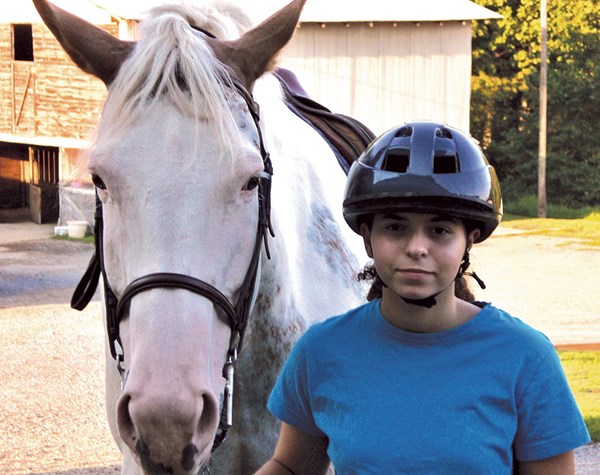
My riding career has been defined by its worst moment: breaking my left femur six years ago after a very unintentional dismount. The lesson stopped when I landed on the ground and the parents on the other side of the fence heard a crack. My leg felt fine, but when I tried to stand up, I was in too much pain to move. At the hospital, the surgeon was able to stabilize the break, and months of physical therapy and walking with crutches allowed the bone to heal.
After 10 months I was ready to ride again, but my confidence fled during lessons. I could walk and trot, but when I cantered my heart started pounding and my brain froze with panic. There was no space for coherent thought or action amid the fear. Luckily, the other people in the ring were able to move around me and avoid another accident.
I was comfortable doing almost everything else: I trotted over poles and turned through serpentines. I knew how to turn and canter, but having to do both at the same time scared me so much that I forgot to ride. How could I remind myself to think rationally when my brain moved to panic mode? I did not have an answer.
Riding became more difficult after spending so much time being inactive. Even though I had the muscle memory to ask my horse to trot, I could not keep my legs still enough to maintain a good position while doing so. I only rode once a week, so my muscles developed slowly without any other exercise.
The other people in the ring only fueled my anger. They were younger and jumping higher. Why were none of them afraid? I saw them as doing what I could be doing if I had not broken my leg. I had no aspirations to show, and I had already succeeded in getting back on the proverbial horse. What more was I trying to accomplish? Was I still having fun? I missed horses during my time on the ground, but riding was much harder than I remembered. My anger and frustration had only one output—myself—and they grew with every lesson that did not live up to my memories of what riding used to feel like. Eventually, I reached a point where I was so upset I forgot how much fun riding could be.
So I took a break. For the next three years I never got on a horse. By physically removing myself from the lesson ring, I gave myself space to analyze the issue from a different angle. I learned that it is possible to enjoy horse-related activities without participating in them. I stayed up late to watch the equestrian events in the 2008 Olympic Games on TV. That time away from horses allowed me to look for them in other places like books and magazines.
Two years later, a friend encouraged me to join the equestrian club at the University of Maryland, Baltimore County. We both had a bad habit of listening to our instincts. When something happened that startled or scared us, we would tense up and lean forward. I would go into full-on panic mode and stay there on my pony’s neck. In the basic rules of riding, this position tells a horse to go forward. The increased speed and loss of control terrified me.
My friend had the same problem. I observed what she was doing when our instructor told her to “sit up and say whoa.” I saw the consequences of giving up your position to cling to the mane in fear. The next time my horse swerved and bolted, I recovered. It took me a few minutes to remind myself that it was better to deal with an uncomfortable canter than to hang onto his neck. I sat up, kept my legs at the girth and applied my slowing aids. After a few moments, we were back to trotting, and I could breathe again. Step by slow step, I was getting there. Conquering my fear of losing control at the canter allowed me to trust myself as a rider again.
Throughout my first semester of college, I wondered if I was making the right choice. Luckily, something happened before I could decide to take another break: I cantered. The pony I was riding maintained a steady canter around the arena. I smiled wide because for the first time in a long time I did not feel any tension. Ever since then, my face has instantly broken into a smile every time I canter.











